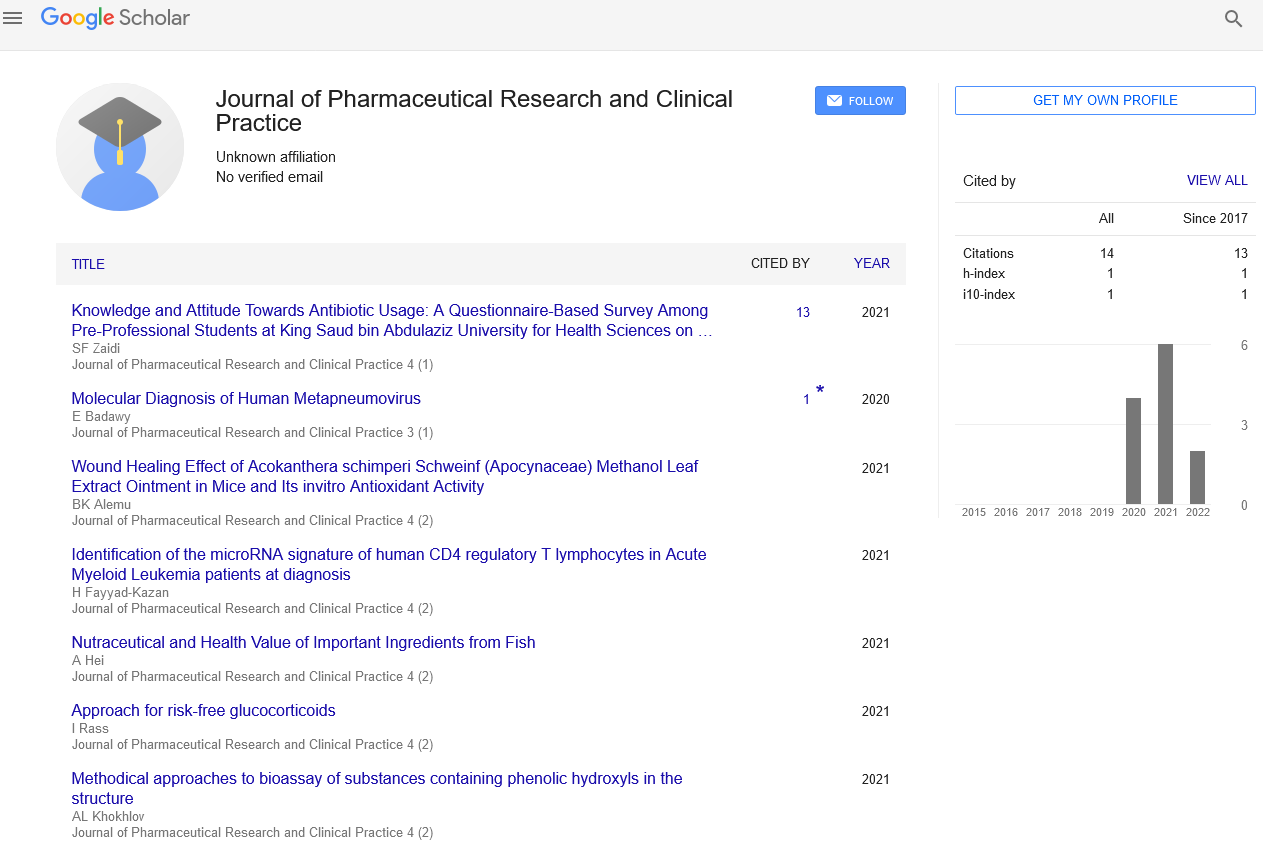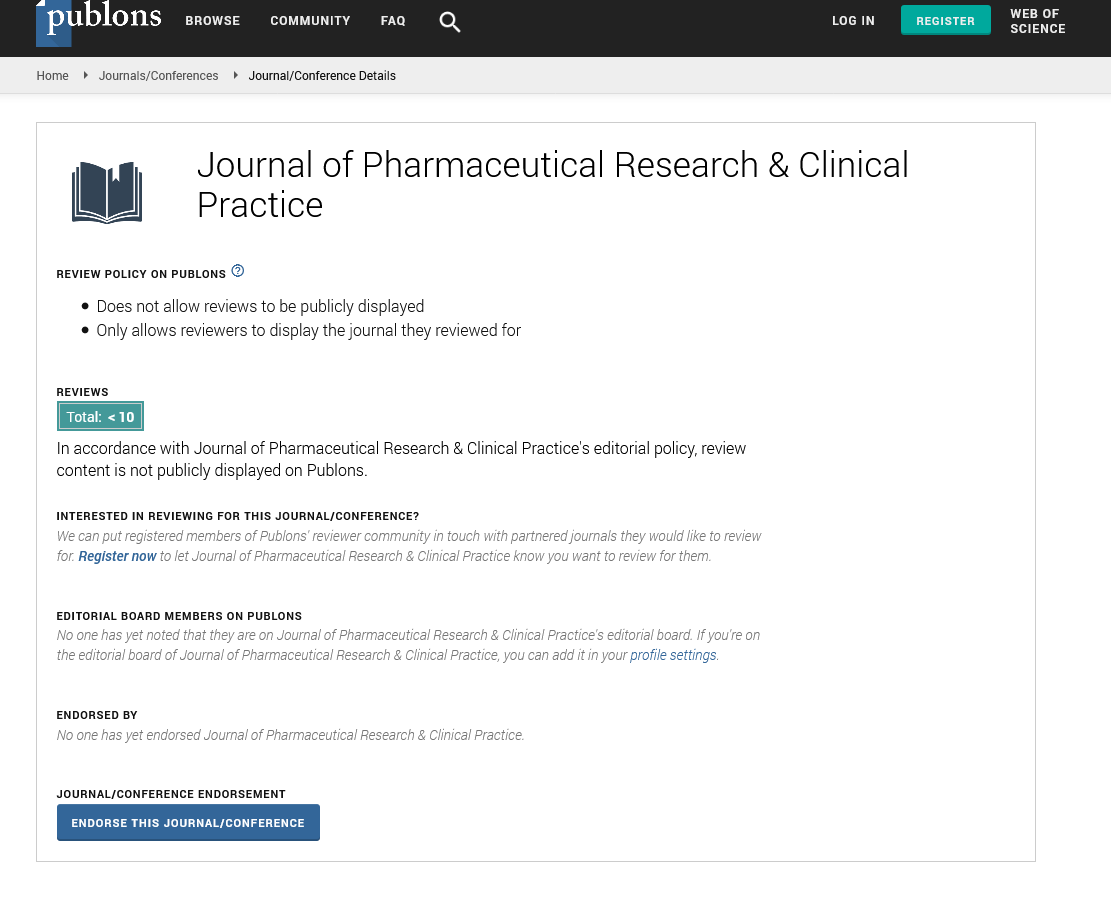Short Article - Journal of Pharmaceutical Research and Clinical Practice (2020) Volume 3, Issue 2
A Study to Determine the Efficacy of Colored Coded Clinical Proformas for Documentation in Obstetric Emergencies
Dr Tracy Roake, RN Brenda Flynn, Dr Faiza Aiman, RN Joyce Calubayan, RM Najat Ould Hadj
Head of Education, Danat Al Emarat
Abstract
The purpose of this study was to determine the efficacy of Color Coded Clinical Proformas (CCCP) for documentation purposes in obstetric emergencies. This study was conducted by Primary Investigator Tracy Roake, Doctor of Business Administration, Registered Nurse and Midwife who performs the role of Head of Education and Student Affairs. The secondary investigators are Clinical Auditor - Faiza Aiman, Nursing Supervisor - Joyce Calubayan, Acting Assistant Chief Nursing Officer - Najat Ould Hadj and Chief Nursing Officer - Brenda Flynn. The study was conducted in a single center healthcare facility which operates as a Joint Commission International Association (JCIA), and Centre of Excellence accredited private women’s and children’s hospital in Abu Dhabi, United Arab Emirates (UAE). The study centre is a certified Research Centre, approved to perform Human Research by Department of Health (DoH), Abu Dhabi, and UAE. The problem that this study aims to highlight is that historically there are variations in obstetric emergencies documentation. While accurate and precise documentation is not usual for some, this study confirms that obstetric emergency documentation was questionable in terms of not being concise and standardised as a whole. The dependent variable in this study is: Documentation The independent variables consist of four processes which include: Compliance with the use of correct proformas, this audit tool was used to collect the data at ease. The analysis helped develop the hypothesis results and extrapolate the research answers. The Excel statistical tool box was utilized by performing the one tail t-test which tested two variables per research question, this was analysed to obtain the p-values. An online eLearning module assessment was employed to assist clinicians in obtaining knowledge regarding CCCP, the results were used to analyse if knowledge transfer occurred. The results also assisted in formulating a plan to update clinicians on their areas of weakness and to provide further recommendation in improving documentation at obstetric emergencies. The process used for tracking the proformas is reiterated in all of the study centers clinical emergency code policies. The system is a simple process in that at the time of the emergency, the scribe should document all the correct information on the proforma, once completed, a photocopy of the proforma is given to the Nursing Supervisor and then delivered to the Chief Nursing Officer (CNO) for a hand over of the event. Once the CNO has reviewed the proforma it is handed to the deputy chair for the resuscitation committee to review so that further discussions can be made in the resuscitation committee meetings.
The study was conducted in a single center healthcare facility which operates as a Joint Commission International Association (JCIA), and Centre of Excellence accredited private women’s and children’s hospital in Abu Dhabi, United Arab Emirates (UAE). The study centre is a certified Research Centre, approved to perform Human Research by Department of Health (DoH), Abu Dhabi, and UAE. The problem that this study aims to highlight is that historically there are variations in obstetric emergencies documentation. While accurate and precise documentation is not usual for some, this study confirms that obstetric emergency documentation was questionable in terms of not being concise and standardised as a whole. The dependent variable in this study is: Documentation The independent variables consist of four processes which include: Compliance with the use of correct proformas, this audit tool was used to collect the data at ease. The analysis helped develop the hypothesis results and extrapolate the research answers. The Excel statistical tool box was utilized by performing the one tail t-test which tested two variables per research question, this was analysed to obtain the p-values. An online eLearning module assessment was employed to assist clinicians in obtaining knowledge regarding CCCP, the results were used to analyse if knowledge transfer occurred. The results also assisted in formulating a plan to update clinicians on their areas of weakness and to provide further recommendation in improving documentation at obstetric emergencies. The process used for tracking the proformas is reiterated in all of the study centers clinical emergency code policies. The system is a simple process in that at the time of the emergency, the scribe should document all the correct information on the proforma, once completed, a photocopy of the proforma is given to the Nursing Supervisor and then delivered to the Chief Nursing Officer (CNO) for a hand over of the event. Once the CNO has reviewed the proforma it is handed to the deputy chair for the resuscitation committee to review so that further discussions can be made in the resuscitation committee meetings.
A tracking system was also developed to ensure this was occurring by which a system was put in place in July 2019. Labour and Delivery Room (LDR) ward clerk checked if any emergencies occurred on a daily basis and followed up on the documentation when required. This was then reported to the Nurse Manger. The tracking process consists of checking the Birth Register to see if an emergency occurred and corresponded with the proforma collected. If for some reason there was a miss, an email was sent to the concerned staff to complete the document within 48 hours and reminded to place the original copy in the patient file and forwarded to the CNO and the deputy chair of the resuscitation committee.
Results:
The results supported the alternative hypothesis in that they suggest that color coded clinical proformas have the ability to produce a desired and intended result. The following questions were asked; results suggested the following:
Q1: Do Color Coded Clinical Proformas make a difference to documentation?
The results suggest that they do; since the implementation of CCCP the clinician is utilizing the proformas more accurately than before, therefore improving the documentation standards in obstetric emergencies. This was data calculated using the one tailed t test. The test calculated a p value of 0.02. High p values of more than 0.05 will indicate that the data is likely with a true null. Low p values less than 0.05 will indicate that the data is unlikely to be a true null.
Q2: Are clinicians using the correct proforma for documentation purposes?
Majority of clinicians are now utilizing the correct proformas to document the emergency, previously there was no standard; as all emergencies where documented on a universal proforma. In the post-implementation period there was an improvement on the way the proformas had been utilized. This result were analysed using the one tailed t test with a p value of 0.03.
Q3: Are the resources in terms of the actions and skills prompted?
When comparing the pre-implementation to the post-implementation phase the results suggest that the resources have been utilized a lot better than before, after analysis comparing both phases the results where a p value 0.0008.
Q4: Are the proformas creating an alert for escalation and improvements?
The results for this question suggest that the escalation process was most of the time complied with. The one tailed t test was utilised in this analysis which resulted in a p value of 0.003. An online eLearning activity was conducted to support the pilot stage of the study. The concept was to reinforce the new change in the way obstetric emergencies are documented. When the results were interpreted, on average the majority of clinicians received a score of 12 out of 13, no one in the sample group received a score lower than 10. Therefore all the participants passed the online eLearning activity suggesting that knowledge transfer has occurred to a degree. However, this will need to be sustained by ensuring this activity is annual.
Conclusion
The conclusion is that effective training on CCCP is imperative for all clinicians no matter their role. During the pilot stage of the study, a CCCP eLearning module education was provided online and served as a knowledge platform to introduce proformas for clinicians to understand the purpose of a proforma. The instructors for the Practical Obstetric Multiprofessional Training (PROMPT) Basic life Support (BLS), Neonatal Resuscitation Programme (NRP) and Advanced Cardiac Life Support (ACLS) courses reiterate the importance of CCCP and allow people to practice the documentation in these simulated environments. CCCP have proven to be beneficial as documentation is now more standardised, clearer and more concise.


